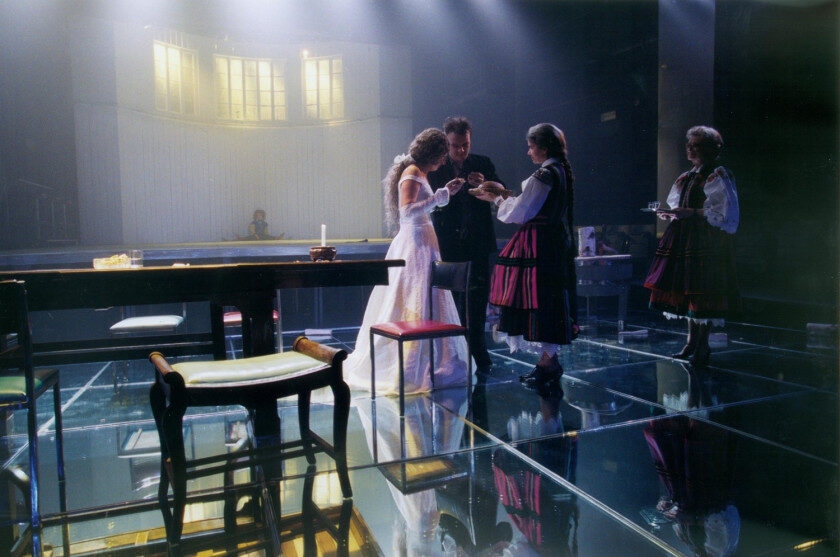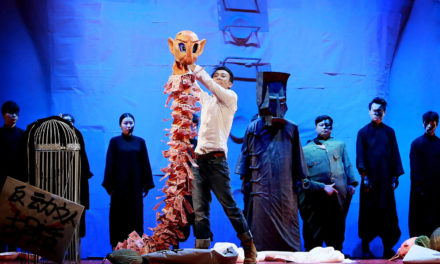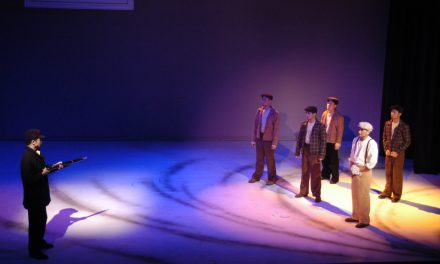Today, Krzysztof Warlikowski is considered one of the most influential auteurs devising for the stage (indeed, his profile was added to Maria M. Delgado’s and Dan Rebellato’s recent re-edition of Contemporary European Theatre Directors). By the mid-2000s his name had considerable resonance in the Polish theatre world, polarising audiences, and critics. His productions tackled works ranging from Euripides, through Marcel Proust to Sarah Kane. His 1998 production of Shakespeare’s The Taming of the Shrew in Warsaw’s Dramatic Theatre saw the comedy approached as a tragedy of domestic abuse. Some perceived his directorial work as an important voice in the debate on post-transformation Poland; others felt the politics of his theatre derailed the universality of Western classics (a problematic assertation in itself) in favor of fleeting publicity.
The 2003 production of The Tempest for Warsaw’s Teatr Rozmaitości (today TR Warszawa) faced just such criticism. For various reasons, it was staged rarely both on its home turf and on tour (compared to other works from Warlikowski’s oeuvre). It was brought back only briefly in the spring of 2008 for a final short set of performances, one of which was filmed. If I can rely on my email archives, I saw the performance on April 26, possibly the last in front of a live audience. The recording took place three days earlier and now remains freely available to stream online. It felt worth revisiting to verify whether time has dulled its political edge. Whether a portion of voices rightfully dismissed it as a piece of theatre journalism, unlikely to have a bearing on, or relatable to, future generations.
The designer, Małgorzata Szczęśniak, made away with period costumes or any hints of fantastical attributes, often utilized in the play’s illustrious stage history. Instead, she used clothing modern to the production’s period, giving the characters an ostensibly mundane look. The performance space was separated into individual areas, with the front of the stage thrust out into the audience, somewhat resembling the architecture of an Elizabethan theatre. The floor of the ‘outer’ stage was tiled with mirrors as the audience was positioned on its three sides. Deeper into the performance area, the inner space was elevated and housed a simple tiled floor, with a plain wooden and windowed wall forming a backdrop.
Warlikowski retained much of Shakespeare’s plot, the most notable omission being the opening scene of a storm, as a result bringing the action straight into Prospero’s (Adam Ferency) household. The play opens with his daughter’s, Miranda’s (Małgorzata Hajewska-Krzysztofik), her face emerging from the darkness as several matches are lit. Finally, the stage is illuminated, revealing a long table populated with paper figurine cut-outs. She comes across as disapproving of her father’s summoning the storm, and her plea to ‘allay’ the ‘wild waters’ is uttered through clenched teeth. Prospero’s unflinching, composed responses posit him as being in complete control of his offspring’s tempestuous emotions and having no second thoughts as to the nature and equity of his actions.
He unravels a tale of his dukedom lost to his sibling. His banishment from Milan, which caused the dethroned ruler to settle on an unnamed isle, is rife with masculine ideas of justice. His brother, Antonio, and the Neapolitan elite traveling with him remain unknowing their itinerary placed them in the vicinity of Prospero’s refuge. They have therefore no reason to fear his vengeance. As the brother’s misdeeds are mentioned, though, Miranda’s rebuttal ‘I should sin / To think but nobly of my grandmother. / Good wombs have borne bad sons’ bears a hit of exasperation as if she was again forced to defend a woman from responsibility for the deeds of a man. Because of this outburst, one can wonder about the absence of the girl’s mother and make guesses as to why senior female figures may cause tensions in this exchange.
Hajewska-Krzysztofik’s character slumps her head down as she slouches through the stage. Her aged face remains hidden behind a curtain of unkempt hair. Her body movement resembles that of a child rather than an adult woman. Though Shakespeare’s play sees her only as a secondary character, Warlikowski puts Miranda centre stage as a misshapen sculpture of her patriarch’s hand. The scene, as the entire play, has each line delivered slowly and studiedly. This pacing leaves space for each subtext and accent to resonate with full force and fill each pause with (often painful) interpersonal dynamics. These are equally palpable in Prospero’s interactions with the native Caliban (Renate Jett) and spirit Ariel (Magdalena Cielecka). Some interpretations saw them, through being played by women, as two other daughters being raised by the former duke. However, their status can be seen as more fluid and not necessarily informed by the biological sex of the performers.
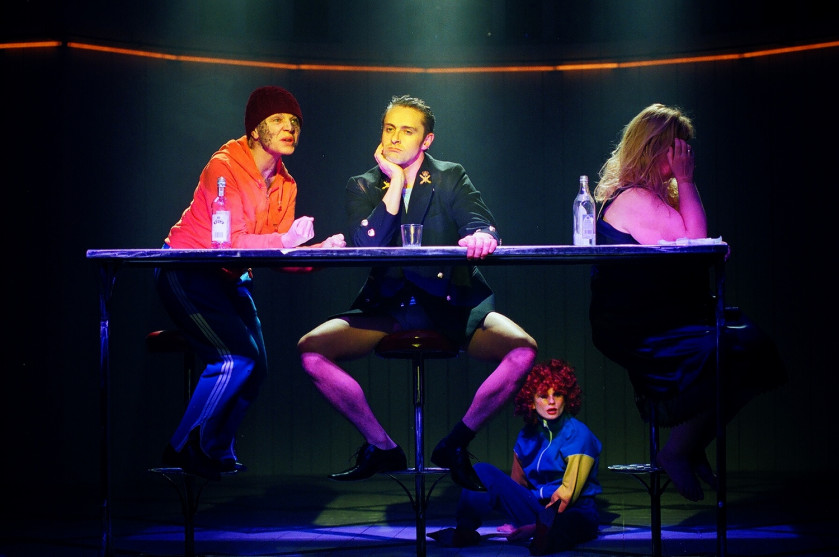
Renate Jett, Jacek Poniedziałek, Magdalena Cielecka, Stanisława Celińska in The Tempest dir. by Krzysztof Warlikowski. Photo by Stefan Okołowicz.
Jett, an Austrian-born actress, inflects the creature’s speech with a foreign accent and animates its movements by creeping and crawling through the set. Its dungarees and a beanie hat look to be a half-hearted attempt to conceal its ‘otherness’, always visible through a large tattoo covering Caliban’s face. Isolated and powerless after Prospero’s conquest of the isle, it makes no secret of the resentment felt towards the usurper. Ariel, in Cielecka’s androgynous iteration, on the other hand, is very much consumed by Stockholm Syndrome. Ferency’s character comes across as having long collected his debt for freeing the sprite from the witch Sycorax. He’s reluctant to grant Ariel freedom and would rather keep them a servant through means of emotional exploitation. As Prospero orders Ariel to ‘make thyself like a nymph o’ th’ sea’, the ghost is quick to reveal their tracksuit jacket conceals a glittery top. A swiftly procured wig covers their pixie cut. Throughout the performance, they will gradually become more of a diva.
As Ariel unzips their jacket, they become increasingly sensual towards the mage. The master counters their desire with steely composure, signaling control and disinterest, perhaps even disgust towards his underling. It certainly feels that Prospero sees (queer) sexuality as a necessary evil, tolerated outside the boundaries of his household, and best not mentioned past his doorstep. This space is reserved for fostering the union between Miranda and Ferdinand (Redbad Klijnstra), the prince of Naples. The noble survived the raging storm and was lured to encounter his bride-to-be with Ariel’s song. The play sees the development of the couple’s journey from their first encounter to their wedding vows as thoroughly orchestrated, with Prospero’s silhouette always visible somewhere in the background.
Ferdinand’s first entrance has him dressed in a tuxedo, making it clear he’s a member of a different world. He scoffs at Prospero’s orders, dismissing them as not for him to obey. As Prospero strips the prince of his privilege and puts him to labor, he delivers lessons in building and exercising authority. Whilst he took no interest in raising his daughter, he seems to know which strings to pull to make Ferdinand into a man in his image. The lessons pay off as in a later scene the lovers exchange tokens of their affection: Miranda gifts Ferdinand with effects of her toils – a seashell necklace, a paper doll – and in exchange receives meaningless, purchased items – a bowtie, a flight ticket. The provenance of the tokens offered by the groom seems to suggest he perceives the marriage as correspondingly transactional.
Ferdinand’s (and Prospero’s) dominance is also marked by Miranda’s body, which always remains clothed and covered as if being censored. Its sexuality is only recognized through the lifting of her skirt at the prince’s need and pleasure in short and awkward acts. These body politics are contrasted with Stephano (Jacek Poniedziałek) and Trinculo (Stanisława Celińska), servants to the elite, seemingly reclused in a gay bar. Stephano’s untrousered legs and facial makeup reminiscent of Joel Gray’s Master of Ceremonies from Bob Fosse’s Cabaret hint at a concealed identity, hidden from his everyday milieu.
Trinculo, equally disheveled in her feminine garments, appears to long for Stephano’s affection – to no avail. Caliban, prone to self-harming and self-depreciation, hopes to get Stephano to overthrow Prospero. It pledges allegiance by kissing and licking his feet. This image which will recur in the performance several times. Not just between the aforementioned pair, as the act will also be offered to Ferdinand by Miranda. In this, the creature makes Stephano question his priorities and awakens his latent lust for power.
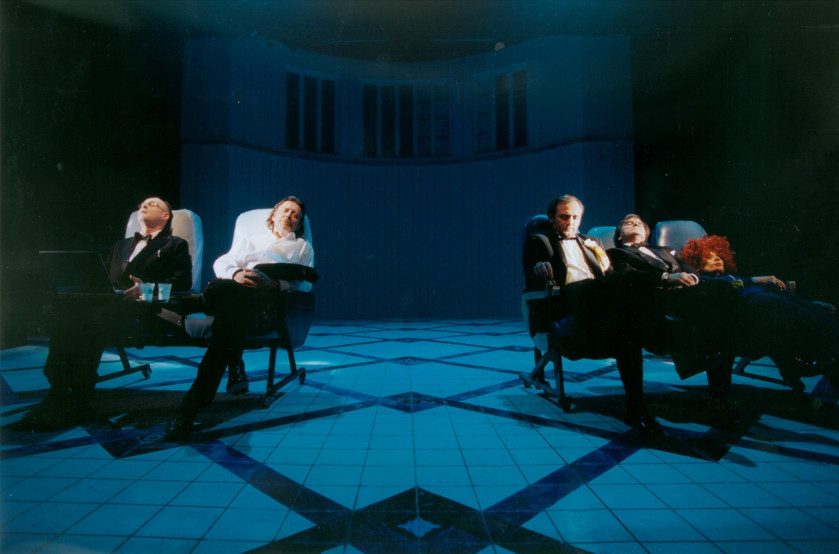
Marek Kalita, Lech Łotocki, Andrzej Chyra, Zygmunt Malanowicz, Magdalena Cielecka in “he Tempest dir. by Krzysztof Warlikowski. Photo by Stefan Okołowicz.
The world of power is embodied by the previously mentioned nobles of Naples and Milan – king Alonso (Zygmunt Malanowicz), his brother Sebastian (Marek Kalita), the royal counsel Gonzalo (Lech Łotocki) and Prospero’s sibling Antonio (Andrzej Chyra). Their tuxedoed looks are justified by their return from a royal wedding in Tunis. Simultaneously, it set them apart from the inhabitants of the isle whilst blurring their individuality. Touches like speech impediments, gestures, and mannerisms liken them to public authority figures contemporary to the time of production. Warlikowski reimagined the elite’s vessel as an airplane, and most of their scenes have them buckled in seats, awaiting an impending crash.
As the disaster arrives towards the performance’s culmination, the nature of the event becomes unclear. Doubles appear behind the doomed passengers, later seen seated at Prospero’s table, bearing witness to Ferdinand and Miranda’s wedding and Prospero’s re-ascension to power. It’s as if their bodies were used to serve a political purpose. Antonio’s notorious silence in the play prompts the director to have him bleeding from the mouth, likely having his tongue severed. They are all waited upon by Stephano and Caliban, as normalized and subservient as Prospero would have liked, their queerness now a distant and forgotten dream. Ariel is no more, having found freedom in the embrace of death.
When the nobles found themselves in the vicinity of the island, they spoke of sleeping and dreaming. Antonio felt being driven ‘by that destiny to perform an act’. But Prospero, in his orchestration of Ariel, makes any destinies witnessed on the stage thus far appear like very much human-made and fuelled by belief. This notion is also central to the nuptial rites, where Ariel’s masque is replaced with a rural Polish ceremony in which matriarchs give the newlyweds instruction. Not only do they heed the couple to bear ‘the sweet but heavy burden of marriage,’ they liken their union to expulsion from the house of the father. In this, they draw parallels to the removal of Adam and Eve from the garden of Eden. Thus, through equating the father, the ruler, to a god, the matriarchs become agents of patriarchy.
There is a large consensus in reading Prospero’s reclaiming of power as an allusion to the Round Table of 1989; an event that set the stage for the transition of power from the communist government to the opposition movement. But the set design, pointing to a dark chapter in Polish history (and heatedly debated at the time of the production’s inception, as it still is to date) questions the innocence of new governing forces. The wooden wall which formed a backdrop of the set resembled the wall of a barn at the center of the Jedwabne pogrom of 1941. It hinted at a presence of fascist attitudes in Poland, and complicated an established narrative of Polish attitudes towards minorities before, during, and after the Second World War.
Warlikowski’s Prospero portrays himself to Miranda as a victim, yet appears to utilize methods that put him alongside his oppressors. Through Ferdinand, he is building a legacy of continuity. Re-engaging with the piece in August 2020, what is perhaps most striking is how the framing of catastrophes in this Tempest can become a palimpsest. With events of the years following the play’s run almost imposing themselves on the mise-en-scène, the production gains a hauntingly prophetic air. If Warlikowski’s diagnosis, as some would have it, was only relevant towards the headlines of the time, why do current headlines resonate so strongly with its contents? Why does it feel that a barn, incinerated eighty-one years ago, keeps casting a ghostly shadow into the present?
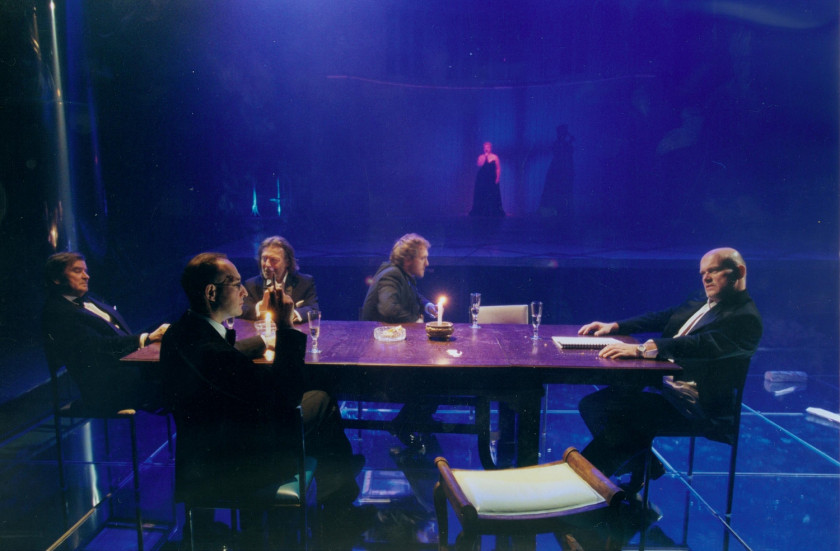
Milanese and Neapolitan elites in “The Tempest” dir. by Krzysztof Warlikowski. Photo by Stefan Okołowicz.
The Tempest
Written by William Shakespeare
Translated into Polish by Stanisław Barańczak
Directed by Krzysztof Warlikowski
Performed by The Teatr Rozmaitości Theatre Company (Warszawa, Poland)
Stage and Costume Design by Małgorzata Szczęśniak
Lighting Design by Felice Ross
Music by Paweł Mykietyn
Available to view at ninateka.pl
This post was written by the author in their personal capacity.The opinions expressed in this article are the author’s own and do not reflect the view of The Theatre Times, their staff or collaborators.
This post was written by Konrad Zielinski.
The views expressed here belong to the author and do not necessarily reflect our views and opinions.

